
The aircraft accident investigation process poses many challenges. The investigation is an integrated management system which requires proper documented procedures, training, job–aids, etc. There are about 66 tasks (called events in Doc 9756, Part II) that each require a specific checklist. Any missing event will lead to the investigation missing an important aspect resulting in the investigation being incomplete and not achieving its objectives. Tracking evidence is a very important aspect of an investigation and therefore evidence handling must be assured, accurate and according to the standards.
GCAA-AAIS management evaluated the investigation process and decided that there would be significant benefits in automating many aspects of the n work and it was decided to develop a software program for this purpose. The program would be called Investigation Smart Manager (ISM).
Over a period of several years ISM has been developed and includes the following features:
- – Contains all of the investigation processes
- – Documents all stages of the investigation
- – Provides alerts to the IIC and the management as critical items require action
- – Contains a dashboard view for the AAIS management
- – Measures productivity
- – Provides query generated reports, etc.
This system is the first of its kind worldwide.
In 2017 due to the heavy workload of IT resources available within the GCAA, the decision to outsource the final ISM development phase to an external software development company was taken.
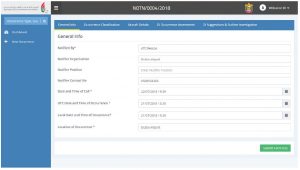
Characteristics of ISM
The Accident Investigation Procedure Manual processes and forms are integrated into ISM to allow all the business processes to be carried out through the System.
ISM is a web-based online application with global access for business continuity. The users are categorized as Management, Investigator and ISM System Administrator.
The management users’ login provides live information on a dashboard with three live charts, which consist of information related to on-going Investigations, Occurrence Notifications received and the status of safety recommendations. The Director of Investigations assigns the investigation to an investigator listed in the system.
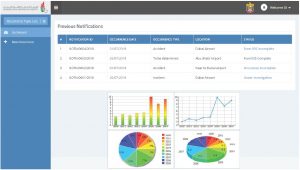
The investigators are notified by email of their assignments When an investigator logs-in to the system, he will get live information on all of the investigations and tasks assigned to him.
The main modules in the ISM system are Notifications, Investigation Process, Correspondence Management, Evidence Management, Reports Management, Safety Recommendations Management and Inventory Management.
Unique features:
The ISM system provides features that allow the investigators to customize the scope of every investigation based on the magnitude and severity of the occurrence. The ICAO Doc 9756 sixty six events guidelines, are incorporated and the system can manage full or partial investigations.
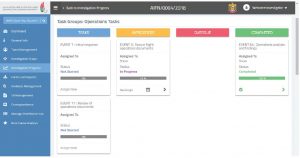
The ICAO Doc 9756 event guidelines are divided into sub-tasks which can be assigned to the investigation team members. The investigation team members are notified by email of the sub-tasks assigned to them.
During the execution of these sub-tasks guidance text is displayed for reference. Sub-tasks have individual provisions for the attachment of evidence, data and information collected, with a text box for details of the outcome of the sub-task to capture for use in the analysis and/or findings.
Reports Management
The data collected and the feedback from one or more team members is formulated into the draft final report which can be generated from the Reports Module at any stage during the investigation.
The draft final report is generated into a Microsoft Word document in editable mode in a standard report writing style. The reports are customized to a pre-formatted writing style based on the approved report writing style manual of the investigation authority.
Different types of reports can be generated at each stage of the investigation. For example, during the notification phase the data collected by the on-duty investigator following the initial notification, is entered into the system. This data is utilized to generate notifications to involved State authorities or interested parties in a single click.
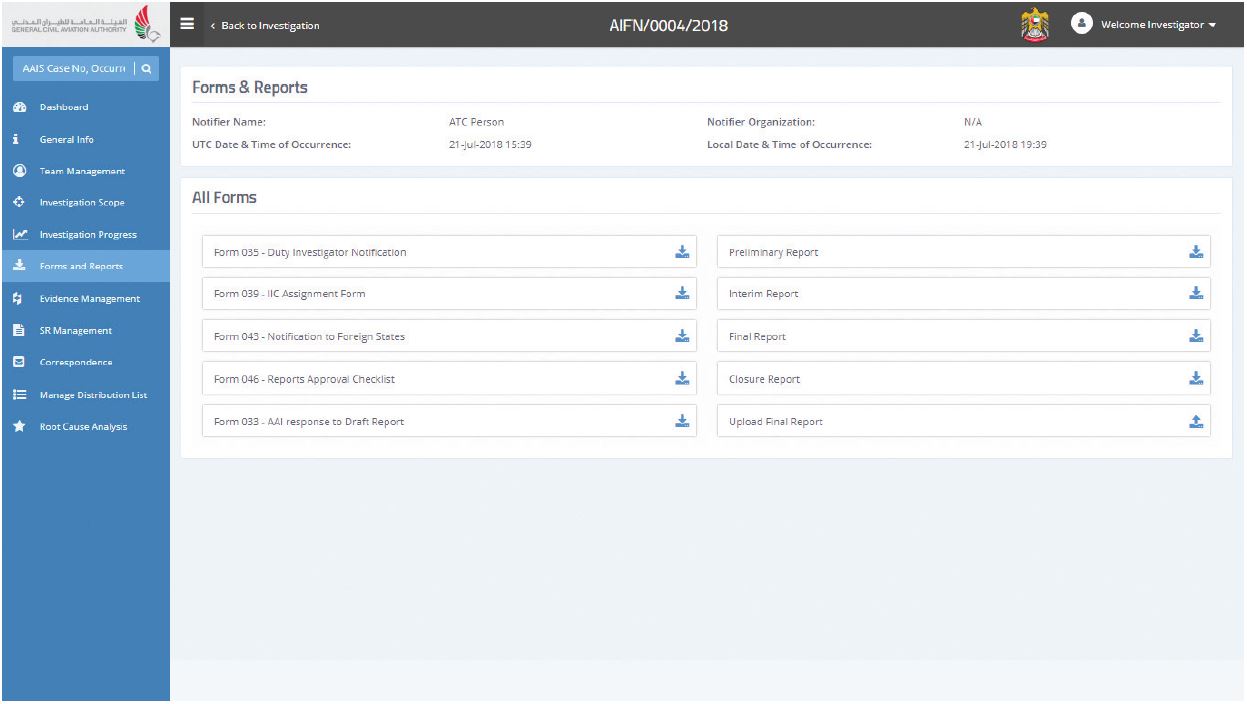
Evidence Management
The evidence collected during the initial stage of the investigation at the accident/incident site requires an organized process so that details can be captured and tracked systematically until the evidence is returned to the owners upon completion of the investigation.
The evidence management module features a quick search facility to track the current status of evidence. The collected evidence is categorized, tagged and identified using unique identification numbers. The results of the functional testing can be attached to each item of evidence with comments included in a text box.
Correspondence Management
All correspondence related to the investigation is integrated within the system which has features to send reminders and notifications by email. The IIC can communicate for each investigation specifically with the appropriate stake holders and save all communications to the correspondence database.
There are options to send documents for approval to the management through the correspondence management system and they can be tracked and reminders can be sent when necessary.
Safety Recommendations Management
The Safety Recommendations (SR) process is the result of each investigation A unique recommendation number is generated by the system for tracking purposes, follow-up and to record the responses and status of each SR.
The automation in this module is the response from the SR recipient, when SRs’ are sent through the correspondence management module by email the recipients can respond by clicking on a link which allows them to access the SR module and to reply to a specific SR assigned to them.
Once the SR assignee logs their response the IIC will receive an email notification. Based on the content of the response the IIC may accept or reject the response. If the response is rejected the SR is returned to the assignee with the reason for rejection and if the response is accepted the system sends a notification to the SR committee for their acceptance or rejection of the SR response.
If the SR response is accepted the SR is closed and notification is sent to the IIC and Director of Investigations, and if it is rejected by the SR committee it is returned to the IIC with the rejection reasoning and it then enters another cycle where it is returned to the assignee who should provide a modified response.
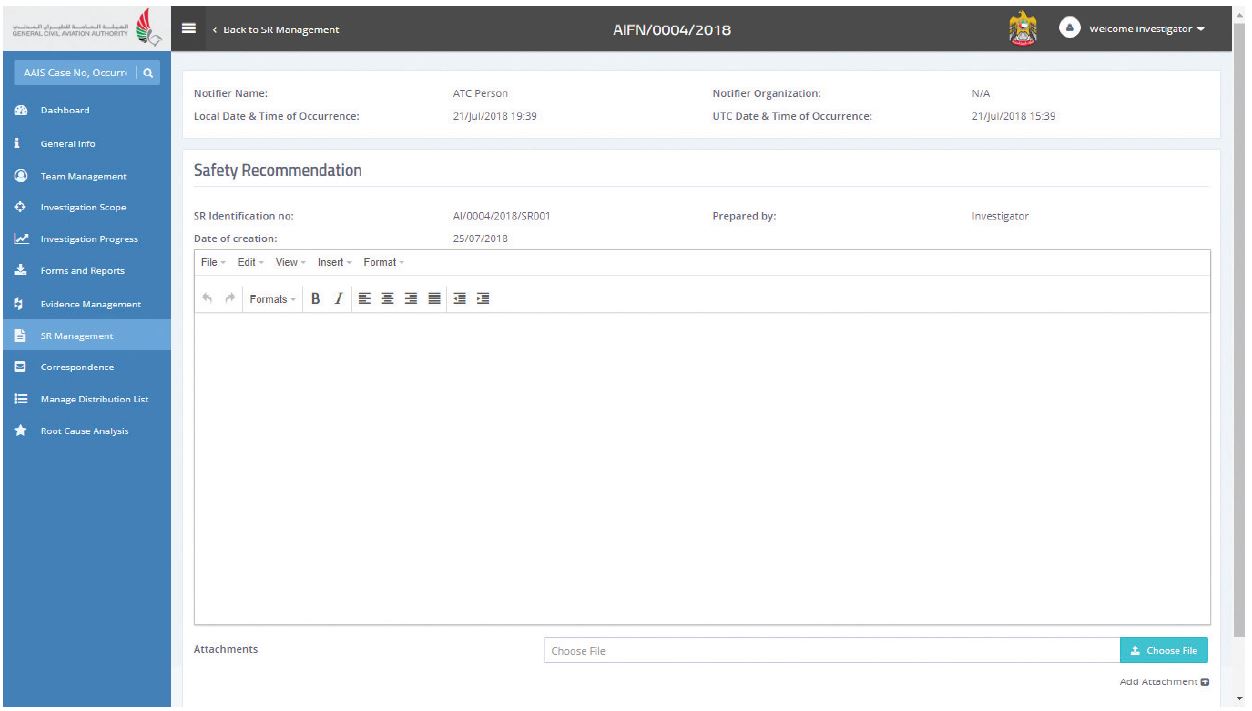
Root Cause Analysis
ISM contains industry standard documented processes for accident and incident Root Cause Analysis. The system incorporates three root cause analysis methods, namely the James Reason, Fishbone and SHELL models. Investigators may utilize these tools, and team discussions, to assist in reaching logical conclusions.
Inventory Management
Investigation tools and go-team equipment kits are crucial to conducting any investigation, and maintaining an equipment inventory is a basic requirement for any organization.
ISM incorporates an Investigation Management module for record keeping of all Personal Protection Equipment, disposable items, equipment maintenance records and records of expiry dates for all perishable items.
The inventory module produces periodic reports to track and update quantities of items used during an investigation, reminders for the periodic maintenance of equipment and tools and also reminders to re-order items should quantities fall below set thresholds. The stock items are listed by category, with photos and serial numbers, if appropriate.
Conclusion
The ISM system provides a complete investigation process management tool, which increases efficiency, and improves and maintains the quality of investigations. Ultimately, the use of such a system by a State investigation authority leads to high quality investigation reports which improve air safety.
Written by: Mr. Khalid Al Raisi, Director AAI, GCAA, UAE
Published on: The Investigator Magazine, Volume 1, Issue 11, October 2018

